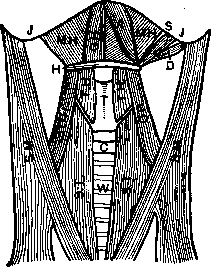Voice Training In Speech And Song - online tutorial
The Structure And Use Of The Vocal Organs, And The Means Of Securing Distinct Articulation.
| Share page | Visit Us On FB |
|
THE VIBRATORY APPARATUS. |
13 |
||
|
are the exact changes that take place in the cords in the production of tone, and in the ascent or descent of the scale. A knowledge of these theories cannot be of any real utility to the student of speech, as the change is brought about by the complicated action of involuntary muscles |
|||
 |
|||
|
Fig. 10.—The Muscles in front of the Neck attached to the Larynx, the Hyoid Bone, H, or the Lower Jaw, J.
SM, Sterno-Maatoid ; OH, Omo-Hyoid; ST, Sterno-Thyroid (Sternum to Thyroid) ; TH, Thyro-Hyoid (Thyroid to Hyoid); MH, Mylo-Hyoid (Hyoid to Lower Jaw); GH, Genio-Hyoid (Hyoid to Lower Jaw); A, Digastric (front part) (Hyoid to Lower Jaw); D, Digastric (back part); S, Stylo-Hyoid ; T, Thyroid Cartilage ; C, Cricoid Cartilage ; W, Windpipe.
(the laryngeal muscles already mentioned), over which there is no direct control; these muscles will, however, work well if they are not interfered with and misplaced by the action of other muscles. What seems to hamper their movements most of all is any rigidity or tightening of the muscles connected with the outside of the larynx, with the hyoid bone, or with the lower jawbone (Fig. 10). To |
|||